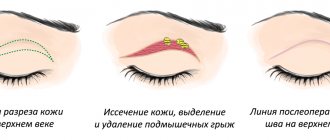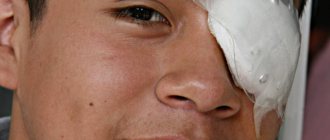The desire for rejuvenation is a characteristic trend of modern society. Therefore, plastic surgery in the facial area is in high demand, despite the existing risks. Blepharoplasty is one of the leaders in plastic surgery. Let's find out how safe it is for vision in this article.
Blepharoplasty is a surgical correction of the upper or lower eyelids, in which the doctor removes fatty hernias, overhanging skin, bags and other defects. As a result of the procedure, the face looks fresher, younger and more toned, the eyes visually become larger and more expressive.
Getting blepharoplasty is the dream of many women, but not everyone decides to undergo the procedure because they are afraid of losing their vision. There is a myth that eyelid surgery leads to a sharp deterioration in visual acuity. Let's figure it out, is this really so?
General characteristics of the intervention
The area around the eyes is the most sensitive area of the skin. It is the eyelids that are the first to undergo age-related changes. Among them are sagging, pigmentation, fine wrinkles, bags under the eyes. If before the age of 30-40 the situation can be regulated with the help of effective care and a healthy lifestyle, then after 40 the time for active action comes. You can decide on drastic changes in appearance earlier. Are you unsatisfied with the shape of your eyes, can’t choose makeup for your looming eyelid, or don’t like the “Mongolian fold”? Consult your doctor and get blepharoplasty.
What do you need to know about the procedure? This is a surgical lift of the upper/lower eyelid for the purpose of visual eye correction or rejuvenation. The method allows you to remove fatty hernias/bags, change the shape of the eyes and give them the desired shape. Please note that blepharoplasty will not be able to remove facial wrinkles that appear in the corners of the eyes. This will require the introduction of special fillers or other cosmetic procedures.
Content:
- General characteristics of the intervention
- How to prepare for plastic surgery?
- Features of blepharoplasty
- Rehabilitation period
- Possible complications and side effects
Types of intervention
There are several types of blepharoplasty that affect different areas of the eye and solve a specific problem. Surgery on the upper eyelid eliminates sagging. This is possible due to a skin incision, which is located along the fold of the upper eyelid. The doctor makes an incision, removes excess skin that causes sagging, and carefully places stitches. Most often, in addition to removing fatty tissue, the doctor performs muscle plastic surgery for a more effective result.
Blepharoplasty of the lower eyelids helps neutralize the hated bags under the eyes. It is known that no cosmetic products can cope with the problem 100%. Bags can be an anatomical feature and appear even in people leading a healthy lifestyle. Additionally, surgery on the lower eyelid will help cope with hernias and swelling. The postoperative suture is localized along the ciliary edge of the eyelid and becomes almost invisible. If necessary, the doctor can make a suture on the inside of the eyelid (transconjunctival blepharoplasty). This type of intervention is especially relevant for young patients, for whom it is enough to remove fatty tissue without direct impact on the skin flaps.
A separate category includes circular blepharoplasty (simultaneous action on the upper/lower eyelid) and correction of the Asian eye shape.
The selection of the intervention method is carried out jointly by the patient and the doctor. Before the operation, you should undergo a comprehensive diagnosis of the body, identify indications/contraindications and determine the desired range of actions. Indications/contraindications for surgery
| Indications | Contraindications |
| Sagging skin of the upper eyelid | Pathologies of the thymus gland, in which muscle tone decreases |
| Skin folds in the eye area | Diseases of the skin around the eyes, regardless of stage |
| Protruding infraorbital fat (bags under the eyes) | Large scars under the skin (after multiple rejuvenation surgeries) |
| Excess skin of the lower eyelid | Presence of fillers in the area around the eyes |
| Asymmetry of the eyes, changes in the incision (both for aesthetic purposes and for direct indications) | Diabetes mellitus (may cause complications during the rehabilitation period) |
| Damage to the skin around the eyes due to mechanical trauma, birth defects | Oncological pathologies, acute/chronic diseases in the acute stage |
| Period of pregnancy/lactation/menstruation in women | |
| Bleeding disorder, anemia | |
| Recent surgery |
Contraindications
Contraindications to transconjunctival blepharoplasty:
- any acute diseases and chronic pathologies in aggravation;
- menstruation in women;
- "dry" eye;
- high intraocular pressure;
- high blood pressure;
- diabetes;
- systemic blood diseases;
- oncological diseases;
- thyroid diseases;
- blood clotting disorders;
- immunodeficiency conditions, including AIDS and HIV.
How to prepare for plastic surgery?
Correcting your appearance is a long process that requires planning and certain preparation. First of all, the patient should undergo diagnostics to exclude contraindications. For a surgeon, the smallest aspects of health are important because they determine how the body reacts to an intervention. If a problem is found in one or more departments (illness/infection/injury/disputable symptoms or test results), the patient is sent to a specialized doctor. The doctor prescribes corrective therapy, monitors its effectiveness and decides on the advisability of aesthetic surgery. If no contraindications are identified, the date of the operation is agreed upon with the patient.
Surgery always carries high risks. The client may not like the result or may disappear within 1-2 years. The plastic surgeon is obliged to provide complete information to the patient and offer possible alternatives. Only after discussing all the nuances can the operation begin.
Features of blepharoplasty
Immediately before the intervention, the patient is given a brief instruction and given an anesthetic (most often general anesthesia). Once all preparations are completed, the surgeon begins the operation. When correcting the upper eyelid, an incision is made along the line of the natural skin fold. The doctor removes the required amount of fatty tissue and skin flaps, if necessary. The surgeon works along pre-marked lines on the human body to obtain the most accurate result. In general, the formation of a new upper eyelid takes from 1.5 to 3 hours.
Correction of the lower eyelid is performed according to a similar principle, but the incision runs along the eyelash growth line. In circumferential blepharoplasty, an incision is made on the inner surface of the lower eyelid. The method is in demand among young patients who are faced with the problem of fatty hernias under the eyes. The surgeon only needs to make one incision, remove excess fat and apply a suture. There is no eyelid correction or removal of additional tissue.
The rejuvenating effect of blepharoplasty lasts for 7-10 years. This indicator may vary and depends on the individual characteristics of the patient.
When is it necessary to visit a doctor?
You should consult a surgeon when complications after blepharoplasty surgery on the upper or lower eyelids interfere with a normal lifestyle. For example, the eye does not close completely or is excessively dry - this may be the result of some problem that has arisen due to surgery.
In general, any changes in appearance or physical well-being that concern you should be a reason to visit a surgeon. This could be any visible defect at the operated site, or, for example, an increase in body temperature or nausea. A timely diagnosis and surgical treatment will help reduce to zero the risks of possible complications after eyelid blepharoplasty.
Following your doctor's recommendations is an important step towards a beautiful look.
Rehabilitation period
Upon completion of surgical procedures, a tight bandage is applied to the patient's eyes. It is forbidden to remove it for the first 4-5 hours. After 5-7 days, the surgeon removes the sutures and fixes the condition of the skin. During this time, swelling and post-operative bruising should subside. Bruising in the operated area can persist for up to 30 days. But this does not mean that the patient will have to spend a whole month of his life in a hospital ward. It all depends on the body’s reaction to the intervention. In most cases, the patient can return to his usual rhythm of life after the stitches are removed. The only caveat is that you will have to devote much more time to your eyes than before plastic surgery. It is necessary to choose hypoallergenic cosmetics, avoid contact lenses, and wear sunglasses every day.
It is important to understand that the patient will experience pain for the first 7-14 days. Its intensity may vary. Some will feel slight discomfort, others will not be able to spend a day without pain medication. Any changes, unpleasant symptoms or suspicions should be reported to your doctor. The patient is prohibited from rubbing, scratching or even touching the eyes. The organs of vision need to be completely relieved of the load. Reading books, surfing the Internet or sitting in front of the TV may be prohibited. Check this aspect with your doctor. If all the rules are followed, the rehabilitation will be successful, and the result of the plastic surgery will please the patient for the next 10 years.
Best materials of the month
- Coronaviruses: SARS-CoV-2 (COVID-19)
- Antibiotics for the prevention and treatment of COVID-19: how effective are they?
- The most common "office" diseases
- Does vodka kill coronavirus?
- How to stay alive on our roads?
Possible complications and side effects
Surgery is a serious stress for the body. It is impossible to predict the body's reaction, so you should be more attentive to any pathological manifestations. The most common complication is swelling. If it persists for 7 or more days, be sure to inform the surgeon about this and make an appointment for an examination. Also, after blepharoplasty, hematomas, suture dehiscence, and restrictions in the activity of the visual organs may develop. If the patient cannot fully open/close his eyes or feels a sharp deterioration in visual perception, this is not a complication, but a mistake by the surgeon. To avoid serious side effects, carefully select a clinic, a doctor, and take postoperative care responsibly.
Blepharoplasty is one of the most popular plastic procedures. It is low-traumatic, and when performed skillfully, it gives an incredible effect. But any surgical intervention is dangerous for the body. Try to solve the problem using conservative methods and agree to surgery only as a last resort. Go through a comprehensive diagnosis, carefully select a clinic, find out the possible risks, consequences, budget and specifics of recovery. It is very important to find “your” doctor who will understand your wishes and be able to implement them. Only in this case the result will be positive.
More fresh and relevant information about health on our Telegram channel. Subscribe: https://t.me/foodandhealthru
We will be grateful if you use the buttons:
Classification of ptosis
Ptosis can be bilateral or unilateral, real or false. False ptosis is characterized by excess volume of skin and subcutaneous tissue, eyelid hernia, strabismus, decreased elasticity of the eyeballs and is usually bilateral, except for unilateral endocrine pathology of the eye.
Moreover, a distinction is made between physiological and pathological drooping of the eyelids. All of the above groups of nerves are associated with the sympathetic nervous system, with the retina, hypothalamus or other structures of the brain, as well as with the frontal, temporal and occipital regions of the cerebral cortex.
Therefore, the degree of muscle tone and the width of the palpebral fissure in the physiological state are in close contact with the emotional state of a person, fatigue, anger, surprise. Blepharoptosis in this situation is bilateral and has an unstable, short-term nature.
Pathological ptosis is formed due to injuries or inflammatory processes of the eyeball or muscles that carry out the movement of the eyelid, with inflammatory processes of the meninges and dysfunctions at different levels in the adductor nervous system with infarctions and brain tumors, disorders of sympathetic innervation and transmission of nerve impulses to the muscles, in case of injury to the upper ends of the spinal cord, lesions of the brachial plexus.
We recommend: What to do if you have eye asymmetry after blepharoplasty?
Depending on the level of the pathological condition, we can distinguish:
- partial ptosis, or 1st degree, in which 1/3 of the pupil is covered by the upper eyelid;
- incomplete (2 degrees) – when part or 2/3 of the pupil is covered;
- full (3 degrees) – complete coverage of the pupil.
Types of ptosis
Depending on the cause, blepharoptosis is divided into:
- congenital;
- acquired;
- congenital ptosis
Congenital ptosis of the upper eyelid is observed:
- with congenital Horner's syndrome, in which ptosis is combined with constriction of the pupil, dilation of the conjunctival vessels, weak sweating on the face and a barely visible deeper location of the eyeball;
- with Marcus-Hun syndrome, which involves drooping of the eyelid, which disappears when opening the mouth, chewing, yawning or moving the lower jaw to the opposite side. This syndrome is considered to be caused by congenital pathological contact between the nuclei of the trigeminal and oculomotor nerves;
- with Duane's syndrome, which is a rare congenital form of strabismus in which there is no displacement of the eye from the outside;
- isolated ptosis, characterized by the complete absence or abnormal development of the levator muscle or its tendon. This congenital pathology is often inherited and is almost always bilateral;
- with congenital myasthenia or anomalies of levator innervation;
- neurogenic etiology, in particular, with congenital paresis of the third pair of cranial nerves.










